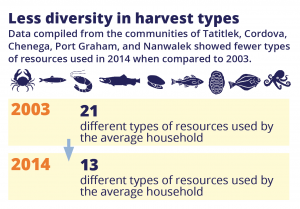
The Exxon Valdez oil spill changed the harvest and use of wild resources in Southcentral Alaska. Various anecdotal reasons such as concerns about oil contamination meant folks were hesitant to use these traditional resources.
The Council recently partnered with the Alaska Department of Fish and Game’s Division of Subsistence to study and document why and how the spill affected subsistence harvesting activities, both immediately after the spill and in the years since.
Fish and Game researchers analyzed data collected from the communities of Cordova, Chenega, Tatitlek, Port Graham, and Nanwalek from 1984 to 2014.
That data confirmed that harvesting decreased during the first few years after the spill, but numbers started recovering around two to three years after the spill. Overall, the rates increased steadily through the 1990s and into the 2000s. By 2014, however, two important facts became apparent.
Reduced diversity of harvested species
 Harvesters collect fewer types of resources than before the spill. Fortunately, the surveys tracked more than just numbers. Interviews with residents pointed to several causes, which changed over time.
Harvesters collect fewer types of resources than before the spill. Fortunately, the surveys tracked more than just numbers. Interviews with residents pointed to several causes, which changed over time.
While the drop immediately after the 1989 spill was mainly attributed to concerns about safety, this was less of a concern in more recent years. Among other causes, interviewees blamed overharvesting by both locals and hunters from outside the community.
A Nanwalek elder interviewed in 2014 noted that easy-to-access locations suffered the most. “Some people don’t have boats so they can’t go too far,” the elder told the surveyors. “They don’t even give ‘em a chance to get bigger.”
Fewer households harvesting more of the resources
Another discovery is that harvesting activities have become more concentrated. In later years, a smaller proportion of households harvested a relatively larger proportion of the resources.
For example, data for sockeye salmon harvests in Tatitlek shows that in 1987, the top 1/3 of the harvesters collected about 55% of the combined total. In 2014, the top 1/3 collected over 90%.
Sometimes those harvests are not shared with the community.
“The oil spill in one way was worse for subsistence and traditional community culture because it gave everyone money, and this gave them the ability for each individual to have their own boat motor,” noted an elder from Nanwalek in 2014. “Lots of people ended up doing subsistence only for themselves and overall, people shared [a lot] less together.”
How does this information help?
This project is helping the Council assess the potential long-term social consequences of the Exxon Valdez oil spill and other factors that may affect subsistence harvests in the spill-affected region. These effects are critical to document to help plan and be prepared in case of a future oil spill.
More about this report:
Watch a presentation by the researchers on our YouTube channel:
Download the report summary:
Study Overview – Recovery Of A Subsistence Way Of Life (1.0 MB)